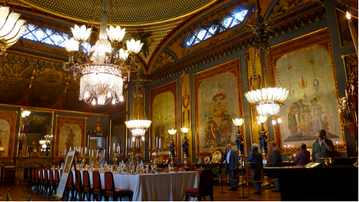
If you’re currently residing in the South East area might I gently nudge you towards an exhibition at the Royal Pavilion Prince Regent Gallery? Charlotte, the Forgotten Princess.
As a Brightonian the Royal Pavilion is very dear to me. All interior design ideas I have can be traced to the Brighton palace (or classic episodes of Changing Rooms) and I fancy myself as pretty well informed when it comes to the Regent and Mrs. Fitzherbert. However, it seems I, along with most of the general public, have forgotten George IV’s only daughter, Princess Charlotte of Wales.
Born on 7 January 1796 the baby princess’s mother was almost immediately forbidden from any role in the upbringing of the Prince Regent’s child. Charlotte was only granted access to her mother in the company of a nurse and governess.
You might think this will of the Prince Regent stemmed from not just sheer hatred of his wife but a real desire to care personally for his daughter. You would be wrong. Continuing to feed his chief interests in gorging and mistresses the prince rarely saw his daughter and so unbeknownst to him, Caroline of Brunswick (herself not much more popular than her husband) would take a carriage around London with her daughter.
Charlotte grew up in what we might now call a broken home. In as much as royalty can anyway.
A lively tomboy, Charlotte’s friend was George Keppel (Alice Keppel’s grandfather in law) who later told tales of ‘fisticuffs’.
Charlotte grew into an accomplished pianist; her handwritten music book will be on display. Her horsemanship was also highly praised but her tendency to show her ankle length underdrawers sparked concern she might be a little…undignified. The Sense and Sensibility character she identified most with was reportedly Marianne.
Having broken her engagement to the Prince of Orange and being instructed by her father to remain at her residence in isolation, the Princess Charlotte raced out into the street. She hailed a hackney cab was taken to her mother’s. Charlotte returned the next day after the Whigs convinced her to do so.
If none of this has endeared the runaway princess to you, how about this note she sent her father as a last word on her broken engagement, "No arguments, no threats, shall ever bend me to marry this detested Dutchman."
Charlotte finally got her way, as every princess should, and married the impoverished Prince Leopold of Saxe-Coburg-Saalfeld on 2 May 1816.
In 1817 after a miscarriage, Charlotte once again became pregnant. Sadly she gave birth to a stillborn boy on the 5 November. After the birth Charlotte complained of pains and began to vomit. Her accoucher Sir Richard Croft found her to be bleeding and cold to the touch. Not long after, the 21 year old princess was dead. 3 months later, her midwife Sir Richard Croft shot himself. Charlotte’s pregnancy went down in medical history as "the triple obstetrical tragedy".
The nation was in mourning of such great proportions that the only comparison to be drawn is that of when Diana, Princess of Wales died.
The exhibition will feature dresses of Charlotte’s, a layette intended for her baby as well as jewellery, prints and art work.
The exhibition is free with Royal Pavilion admission fee and runs from 10 March 2012-13
Adult £10, child (5-15 years) £5.70, concession £8
Brighton & Hove resident (with proof of address) £5
London to Brighton trains are regular, if you can't find your way to the Pavilion from the station then I wash my hands of you.
Squeamish Kate
 RSS Feed
RSS Feed
